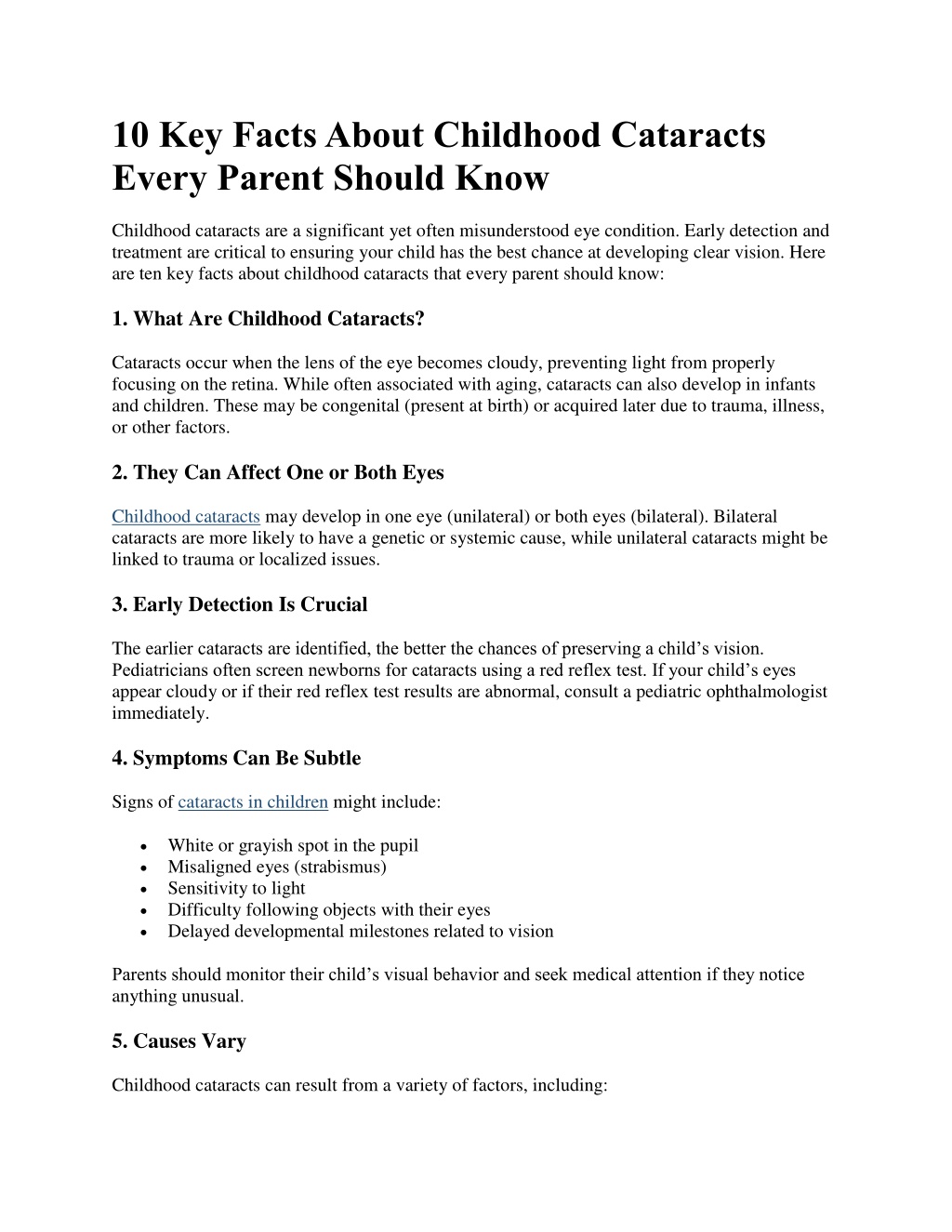
10 Key Facts About Childhood Cataracts Every Parent Should Know
Childhood cataracts are a rare but significant condition that can affect a childu2019s vision and overall development. This guide provides essential information for parents to understand this condition better. Learn about the types of childhood cata
Download Presentation

Please find below an Image/Link to download the presentation.
The content on the website is provided AS IS for your information and personal use only. It may not be sold, licensed, or shared on other websites without obtaining consent from the author. Download presentation by click this link. If you encounter any issues during the download, it is possible that the publisher has removed the file from their server.
E N D
Presentation Transcript
10 Key Facts About Childhood Cataracts Every Parent Should Know Childhood cataracts are a significant yet often misunderstood eye condition. Early detection and treatment are critical to ensuring your child has the best chance at developing clear vision. Here are ten key facts about childhood cataracts that every parent should know: 1. What Are Childhood Cataracts? Cataracts occur when the lens of the eye becomes cloudy, preventing light from properly focusing on the retina. While often associated with aging, cataracts can also develop in infants and children. These may be congenital (present at birth) or acquired later due to trauma, illness, or other factors. 2. They Can Affect One or Both Eyes Childhood cataracts may develop in one eye (unilateral) or both eyes (bilateral). Bilateral cataracts are more likely to have a genetic or systemic cause, while unilateral cataracts might be linked to trauma or localized issues. 3. Early Detection Is Crucial The earlier cataracts are identified, the better the chances of preserving a child s vision. Pediatricians often screen newborns for cataracts using a red reflex test. If your child s eyes appear cloudy or if their red reflex test results are abnormal, consult a pediatric ophthalmologist immediately. 4. Symptoms Can Be Subtle Signs of cataracts in children might include: White or grayish spot in the pupil Misaligned eyes (strabismus) Sensitivity to light Difficulty following objects with their eyes Delayed developmental milestones related to vision Parents should monitor their child s visual behavior and seek medical attention if they notice anything unusual. 5. Causes Vary Childhood cataracts can result from a variety of factors, including:
Genetic conditions like Down syndrome Infections during pregnancy, such as rubella or toxoplasmosis Eye injuries Certain metabolic disorders, like galactosemia Unknown causes (idiopathic) Understanding the root cause can help guide treatment decisions. 6. They Impact Vision Development Unlike adults, children with cataracts face a unique challenge: their visual system is still developing. A cataract can interfere with this process, potentially leading to amblyopia (lazy eye) or permanent vision impairment if not treated promptly. 7. Treatment Often Requires Surgery Most cases of childhood cataracts require surgical removal of the cloudy lens. The timing of surgery is critical and depends on the severity and age of the child. Delaying treatment can hinder visual development. 8. Vision Correction Is Usually Necessary Post-Surgery After cataract removal, children typically need corrective lenses or contact lenses to replace the focusing power of the removed lens. In some cases, an intraocular lens (IOL) may be implanted, depending on the child s age and condition. 9. Post-Treatment Care Is Long-Term Managing childhood cataracts doesn t end with surgery. Ongoing care may include: Regular eye exams Wearing glasses or contact lenses Eye patching to treat amblyopia Vision therapy to strengthen the eye-brain connection Parents play a vital role in adhering to these follow-up treatments to ensure the best outcomes. 10. Family Support and Awareness Are Essential Caring for a child with cataracts requires awareness, patience, and support. Joining parent groups or speaking with a pediatric eye care specialist can provide valuable guidance and reassurance. Encouraging your child to embrace vision aids, like glasses, can also boost their confidence and help them adapt.
Final Thoughts Childhood cataracts are a serious but manageable condition. With timely intervention and proper care, children with cataracts can achieve excellent visual outcomes and lead normal, healthy lives. If you suspect your child might have a vision issue, don t hesitate to seek professional help. Early action is the key to preserving their sight and supporting their overall development.






















